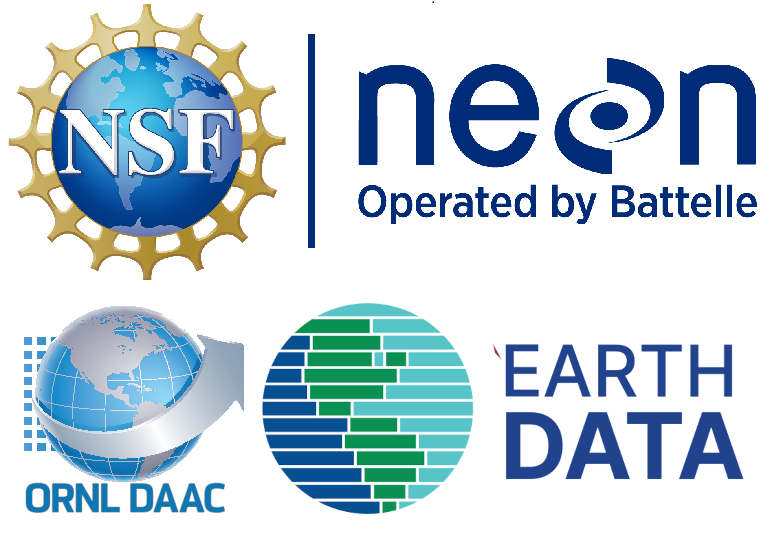Comparing NEON and NASA Airborne Campaigns and Datasets
While NASA and NEON operate similar imaging spectrometer instruments, there are a number of differences between the two in terms of the goals driving the airborne campaigns as well as the datasets provided. This section provides a high-level overview of some of the similarities and differences between the two. Table 1 shows some of the differences in terms of the major questions (when, where, why) about the two missions. Table 2 compares some of the differences in terms of the data products, processing methods, and data management (storage and access).
| Parameter | NASA AVIRIS | NEON AOP |
|---|---|---|
| Why? | Campaign-driven: Specific research questions | Long-term ecological monitoring of sites across the United States |
| Where? | Worldwide (U.S., South Africa, Central America) | 80 sites throughout the continental U.S., Alaska, Hawaii, and Puerto Rico |
| When? | 1986 - present (AVIRIS-NG first collections in 2012); campaigns may occur over short season or spanning multiple years | 2012 - present; NEON sites are collected roughly 3 out of every 5 years |
While both NEON and NASA provide free, open datasets, the major difference between the NEON and NASA remote sensing airborne campaigns is related to their missions. NEON’s overarching mission is to produce a long-term archive of standardized data over the same sites over a 30 year time period, in order to provide a picture of long-term ecological change. NASA’s missions are campaign-driven, meaning that each campaign is typically designed around a specific research question, or instrument testing in some cases. For a more complete list of the NASA airborne campaigns hosted by the ORNL DAAC, refer to Datasets from Airborne Campaigns. Despite the differences in the drivers of the missions, the NEON and NASA datasets provide complimentary hyperspectral data, which could be used together for studies in their own right. In addition, both field and airborne datasets provide ground-truth (or close to ground-truth) sources that can help calibrate and validate data acquired from NASA’s upcoming Surface Biology and Geology SBG satellite mission.
Data Attributes
| Parameter | NASA AVIRIS | NEON AOP |
|---|---|---|
| Data Products | L1B Calibrated Radiance, L2 Surface Reflectance | L1: Radiance and Reflectance, L2: Derived Indices (Flightline), L3: Reflectance and Derived Indices (Tiled) |
| Flight Altitude | ? | 1000m AGL |
| Data Resolution | 1 - 5m (varies depending on altitude flown) | 1m |
| Atmospheric Correction Method | ISOFIT | ATCOR |
| Data Storage Platform | AWS | GCP |
| Data Portal URL | https://daac.ornl.gov | https://data.neonscience.org |
| Open-source packages | earthaccess (Python) | neonUtilities (R), neonutilities (Python) |
Data Products
NEON data are processed to Level 1 (flightline), Level 2 (derived; flightline) and Level 3 (derived; tiled mosaic) data products, and include a number of derived data products such as vegetation and water indices, LAI, fPAR, and Albedo. NASA data are processed to Level 1 (flightline) radiance, however some missions (e.g. BioSCape) have been mosaicked and tiled.
Data Processing
Atmospheric correction
NEON uses ATCOR-4 for the atmospheric correction. NASA uses ISOFIT. There may be differences data derived from NEON v. NASA due to the different atmospheric correction method applied, as well as other corrections. NEON and NASA have been in communication about using the same atmospheric correction algorithm (ISOFIT) but this is still being scoped out.
Data Storage and Access
NEON
NEON data are stored on Google Cloud Storage (GCS) and are accessible via the NEON Data Portal. A subset of the L3 data products are also available on Google Earth Engine.
NEON provides an API for downloading from the Data Portal, and has developed tools in R (neonUtilities) and Python (neonutilities) for downloading NEON data, and wrangling OS and IS data.
NASA
NASA airborne data are stored on Amazon Web Services (AWS) and can be accessed through the ORNL DAAC. NASA provides tools including Earthdata Search as well as the Python earthaccess package to help data users discover and download datasets.
